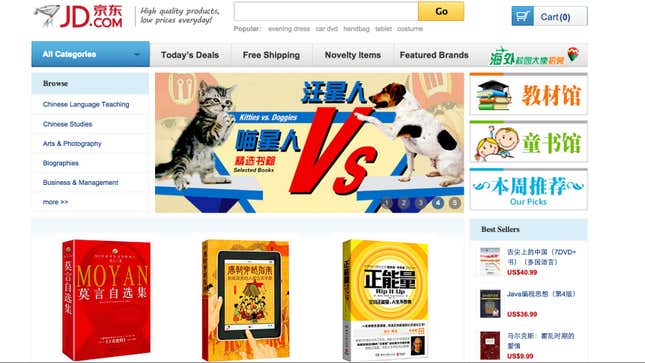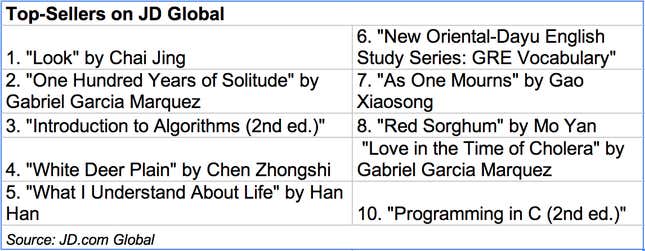
Ferocious competition in China’s online retail market has gnawed profit margins down to almost nothing, so opening up sales channels overseas is key. The problem: what does China make that global consumers actually want?
We recently covered how one Chinese company is answering that question (wedding dresses). Now the Amazon-like online retailer Jingdong, which used to be 360buy.com, says it has struck on another answer: books. To be specific, Chinese-language books.
“When we were looking for different market needs that were unmet abroad, we thought back to the experiences of people like myself who lived abroad extensively. Cultural items, and specifically books, which are hard to travel with, were something that were always hard to find in the US,” says Shi Tao, Jingdong’s vice president of retail and overseas markets. The company’s global site in launched in October 2012.
“There are only limited numbers of Chinese book stores with narrow selections abroad, which give us a huge opportunity to expand overseas markets,” Shi added. Mind you, it’s not huge yet. Shi emphasizes the company’s still “testing the waters,” and declined to share numbers.
And though it’s selling those through its global site, the “global consumers” Jingdong is reaching are mainly overseas Chinese, primarily in the US. That’s not a tiny audience. Chinese immigrants in the US totaled 1.8 million in 2010, and that’s not counting millions of naturalized citizens and US native Chinese-readers. The company shared JD.com Global’s sales top sales destinations with Quartz, and they were a little…surprising

It’s no big shocker that New York and LA would have a lot of Chinese-readers. Manhattan is home to 91,500 Chinese-Americans, while LA has around 74,000. But Pittsburgh, Ann Arbor and Lincoln in the top 10, and Gainesville, Ames and East Lansing rounding out the top 15—what gives? There’s an easy answer: Those are all big university towns, with large Chinese student populations (though University of Nebraska-Lincoln’s appears to be but a little more than 1,200).
Here’s what’s selling:

Newly popular Chinese non-fiction, recent literary classics, study aids and Colombian magical realism (Garcia Marquez has long been popular in China, in case you’re wondering)—it’s a mix that screams “student.” And that makes sense: Young Chinese are more likely to be familiar with Jingdong than long-time US residents.
There’s continuing potential here: nearly 200,000 Chinese people studied in the US last year (pdf), up 23% on the previous year. The trick is attracting non-student Chinese readers. The field is wide open, though—it’s bizarrely hard to get Chinese-language books in the US. Amazon, for instance, doesn’t appear to be searchable in Chinese characters and has a limited selection.
Still, even with a corner on that market, the business is a tough one. A spokesperson for Jingdong tells Quartz its revenue was over $160 million last year, but declined to specify further. That would put it ahead of Dangdang.com’s $150 million in 2012 book sales. However, Publishing Perspectives projects Jingdong’s book sales to jump to $242.8 million this year. Shi, meanwhile, emphasized that the company is still tinkering around with strategies for the overseas site, but the company’s reticence suggests that global sales will be but a drop in that bucket.